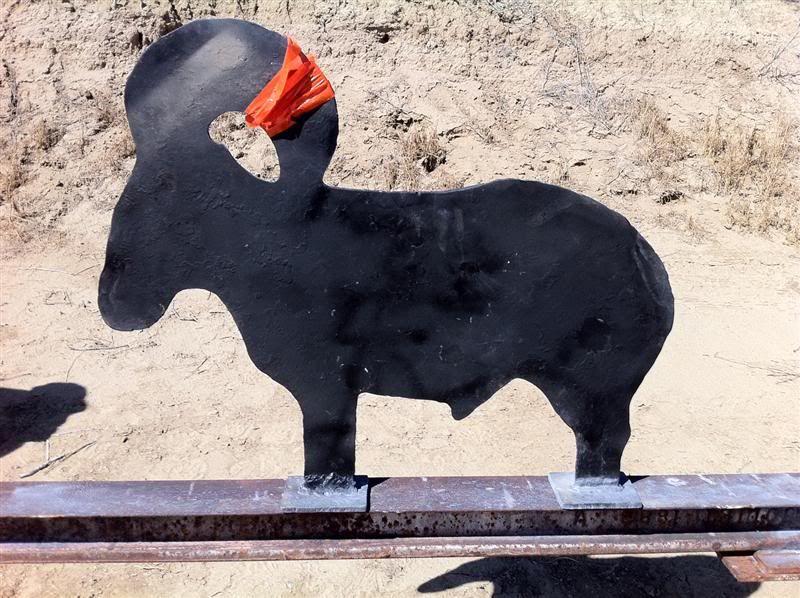I have a question on <span style="font-weight: bold">Momentum </span>in regards to bullets striking "armor plate" steel, and I don't have the background to prove/disprove the theory.
Here is the scenario... I shoot in Metallic Silhouette competitions where we shoot at metal shaped animals at varying distances. They are cut from a type of armor plate (no target damage at 550yds). There is always a constant debate in regards to the best caliber (.308, 7mm and 6.5mm). In regards to the 6.5mm projectiles at our 550 yard targets there is a theory that there is a velocity threshold that by driving the bullets too fast that they will not expend their momentum into the target, instead the bullets will disintegrate more rapidly and the direction of momentum will change to the sides instead of knocking the target over.
In layman's terms, we HAVE to knock the targets over for the hit to count towards our score. Sometimes we will "ring a Ram" which means that we hit the Ram (550yds) solid but it doesn't fall down. It just stands there and you hear the ring of the hit and see the bullet splash. Even though you hit it you don't get to count it.
So, like I said there is a theory that there is a fine line between "fast enough" and "too fast". Myself and a buddy want to build a Ballistics Pendulum to test the theory in real life but I want to think out loud before going through the exhaustive process of testing.
If I understand momentum correctly (p=m*v) (m=mass in Kg, v=velocity in meters/second), and I input the numbers for a 140gr projectile traveling at approximately 1874fps (6.5mm 140gr bullet at 550yds). Converting the bullet to kilograms I get .009072kg and converting velocity to meters/second I get 571.1952m/s. Out of the momentum formula <span style="font-weight: bold">I get (5.1819kg * m/s)</span>. So the BIG question is... is it possible that by going <span style="font-style: italic">faster</span> that the momentum could actually decrease due to bullet disintegration?
Now this doesn't take into account the angle of impact, nor does it take into account that there is nothing at the target to absorb(capture) all of the bullets momentum (the targets are undamaged and the bullets do disintegrate).
I guess, is there a point of diminishing returns?<span style="font-weight: bold"> At what velocity does momentum actually stop going up... and start going down?</span>
Hopefully there is someone on the hide that can help me theorize this before I get balls deep in fabricating a ballistics pendulum to test it.
Here is the scenario... I shoot in Metallic Silhouette competitions where we shoot at metal shaped animals at varying distances. They are cut from a type of armor plate (no target damage at 550yds). There is always a constant debate in regards to the best caliber (.308, 7mm and 6.5mm). In regards to the 6.5mm projectiles at our 550 yard targets there is a theory that there is a velocity threshold that by driving the bullets too fast that they will not expend their momentum into the target, instead the bullets will disintegrate more rapidly and the direction of momentum will change to the sides instead of knocking the target over.
In layman's terms, we HAVE to knock the targets over for the hit to count towards our score. Sometimes we will "ring a Ram" which means that we hit the Ram (550yds) solid but it doesn't fall down. It just stands there and you hear the ring of the hit and see the bullet splash. Even though you hit it you don't get to count it.
So, like I said there is a theory that there is a fine line between "fast enough" and "too fast". Myself and a buddy want to build a Ballistics Pendulum to test the theory in real life but I want to think out loud before going through the exhaustive process of testing.
If I understand momentum correctly (p=m*v) (m=mass in Kg, v=velocity in meters/second), and I input the numbers for a 140gr projectile traveling at approximately 1874fps (6.5mm 140gr bullet at 550yds). Converting the bullet to kilograms I get .009072kg and converting velocity to meters/second I get 571.1952m/s. Out of the momentum formula <span style="font-weight: bold">I get (5.1819kg * m/s)</span>. So the BIG question is... is it possible that by going <span style="font-style: italic">faster</span> that the momentum could actually decrease due to bullet disintegration?
Now this doesn't take into account the angle of impact, nor does it take into account that there is nothing at the target to absorb(capture) all of the bullets momentum (the targets are undamaged and the bullets do disintegrate).
I guess, is there a point of diminishing returns?<span style="font-weight: bold"> At what velocity does momentum actually stop going up... and start going down?</span>
Hopefully there is someone on the hide that can help me theorize this before I get balls deep in fabricating a ballistics pendulum to test it.





